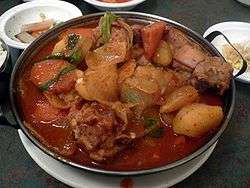Dakbokkeumtang
 | |
| Type | Guk |
|---|---|
| Place of origin | Korea |
|
| |
| Dakbokkeumtang | |
| Hangul | 닭볶음탕 |
|---|---|
| Revised Romanization | Dakbokkeumtang |
| McCune–Reischauer | Takpokkŭmt'ang |
Dakbokkeumtang or Daktoritang is a spicy braised chicken Korean cuisine stir-fried in a condiment of gochujang, soy sauce, green onions and garlic, boiled until a bit of soup is left. This chicken cuisine is considered as a type of Korean jorim. The minor ingredients are potatoes, onions and carrots.[1]
Etymology
The original name of the dish is 'dakdoritang' (닭도리탕), but the name is controversial. In both North and South Korea, there have been movements to promote linguistic purism in the Korean language, and removing the Japanese loanwords introduced during the colonial period (1910-1945) has been of primary interest. In South Korea, the National Institute of the Korean Language formally replaces loanwords with pure Korean. 'Gimbap' (김밥; "seaweed rice") is a pure Korean word formalized in 1977 to replace `norimaki' (노리마키), a loanword from the Japanese `nori-maki' (のり巻き; "seaweed roll").[2] In contrast, 'dakbokkeumtang', a pure Korean first suggested by netizens to replace the original name 'dakdoritang', due to the similarity of 'dori' (도리) to the Japanese word 'tori' (とり; "bird"), has not been formalized.
The etymology of 'dakdoritang' is uncertain, and the status of `dori' as a loanword has been subject to debate. The National Institute of the Korean Language does not view it as a loanword. Its current position is that 'dori' (도리) is a cognate of the infintive 'dorida' (도리다; "to turn around and carve"), and refers to the chicken being cut into pieces before cooking. But the usage of 'dorida' in Korean is rare, and this etymology is not widely accepted.[3]
An alternative etymology is that the orthography reflects phonetic changes in pronunciation. Rather than a type of 'bokkeum' (보끔 [bok͈.ɯːm]; stir-fried cuisine), the dish is a type of 'jorim' (조림 [dʑo.ɾim]; soy-braised cuisine), which may have been originally known as 'dakjorimtang' (닭조림탕 [dak.dʑo.ɾim.tʰaːŋ]); and the name `dakdoritang' is the phonetic representation of consonant assimilation, where succeeding syllable assimilate the onset stop ㄷ /d/ in the first syllable 닭 [dak]:
닭조림탕 [dak.dʑo.ɾim.tʰaːŋ] > 닭도리탕 [dak.do.ɾi.tʰaːŋ]
- 조 > 도; the onset affricate ㅈ /dʑ/ changes into a stop, ㄷ /d/.
- 림 > 리; the coda nasal ㅁ /m/ is removed.
Although consonant assimilation is common in the Korean language, Korean orthography does not generally reflect assimilation, and maintains the underlying morphology, e.g., Jeolla-do (전라도). But phonetic representations in orthography do occur, e.g., 'seolleongtang'.
References
- ↑ 닭볶음탕 : 두산백과
- ↑ "Refined word (purified word) Norimaki[노리마키]". Government and Media Loanword Joint Review Committee [정부.언론외래어심의공동위원회].
- ↑ Controversy on dakbokkeumtang